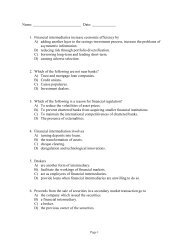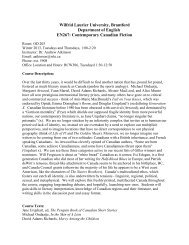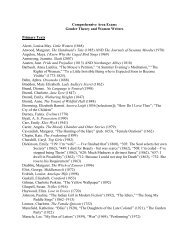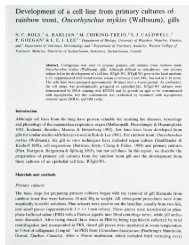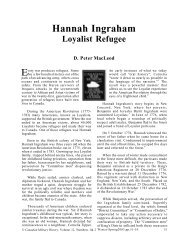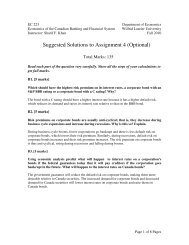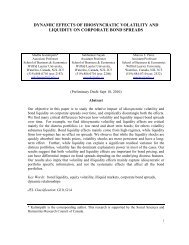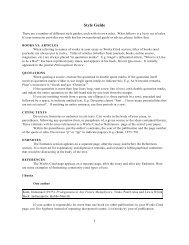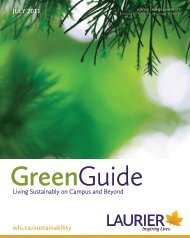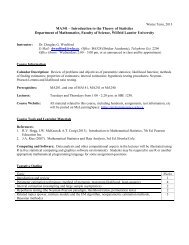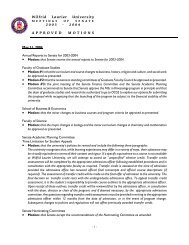Taxonomy of the Polygonum douglasii (Polygonaceae ... - WLU
Taxonomy of the Polygonum douglasii (Polygonaceae ... - WLU
Taxonomy of the Polygonum douglasii (Polygonaceae ... - WLU
Create successful ePaper yourself
Turn your PDF publications into a flip-book with our unique Google optimized e-Paper software.
2 BRITTONIA<br />
[VOL. 57<br />
DAO, DC, DS, GH, F, JEPS, LL, MT,<br />
MTMG, NY, OAC, POM, QFA, RSA,<br />
SASK, TEX, UBC, UC, US, and USAS.<br />
Mature plants with leaves, flowers, and<br />
achenes are necessary for accurate determinations.<br />
Plants parasitized by homopteran<br />
insects are atypical. Their internodes are<br />
shortened, cymes have numerous flowers,<br />
and inflorescences are denser; flowers are<br />
brownish, sterile, and pedicels may be erect<br />
even in taxa in which <strong>the</strong>y are normally reflexed.<br />
Papillae are easily observed on<br />
young stems or toward apices <strong>of</strong> mature<br />
stems and branches, at magnifications higher<br />
than 50�. Measurements <strong>of</strong> leaves and<br />
ocreae were made at <strong>the</strong> middle <strong>of</strong> <strong>the</strong> main<br />
stem. The state characters, ‘‘flowers<br />
closed,’’ ‘‘flowers semiopen,’’ and ‘‘flowers<br />
wide-open’’ were noted on herbarium specimens.<br />
Description <strong>of</strong> perianth refers to <strong>the</strong><br />
fruiting perianth, which was measured from<br />
<strong>the</strong> joint with <strong>the</strong> pedicel. Morphology <strong>of</strong><br />
pedicels was noted in fruit. Measurements<br />
<strong>of</strong> dry an<strong>the</strong>rs were obtained from SEM<br />
pictures (see below).<br />
MICROMORPHOLOGY<br />
Samples (Appendix 1) were collected<br />
from typical herbarium specimens within<br />
<strong>the</strong> holdings <strong>of</strong> CAS, DS, GH, JEPS, NY,<br />
RSA, UC, and USAS. Samples were coated<br />
with 30 nm gold using an Emitech<br />
K550� Sputter Coater and examined with<br />
a Hitachi S-570 at 15 KV. Micromorphology<br />
<strong>of</strong> <strong>the</strong> following organs or plant parts<br />
was examined: mature stems and leaves,<br />
fruiting perianth, and pollen. Surface pattern<br />
<strong>of</strong> perianth was studied on <strong>the</strong> borders<br />
<strong>of</strong> <strong>the</strong> outer perianth lobes. Standard terminology<br />
for cell types and surface sculpturing<br />
patterns follows Ronse Decraene<br />
and Akeroyd (1988), Barthlott et al.<br />
(1998), and Hong et al. (1998). Pollen terminology<br />
follows Hoen (1999). Description<br />
<strong>of</strong> achene morphology and micromorphology<br />
follows <strong>the</strong> terminology developed<br />
by Wolf and McNeill (1986) and<br />
Ronse Decraene et al. (2000).<br />
STEMS<br />
Results<br />
Stems are 4-angled, with smooth (Fig.<br />
1A) or minutely and irregularly ribbed fac-<br />
es (Fig. 1C, D, F). Epidermis cells are rectangular<br />
or elongated, with epicuticular wax<br />
consisting <strong>of</strong> longitudinal rodlets (Fig. 1C).<br />
Stomata are frequent, mostly anisocytic<br />
(rarely a few may be anomocytic). Presence<br />
<strong>of</strong> papillae is a distinctive feature observed<br />
in many taxa. Papillae may be distributed<br />
on <strong>the</strong> stem angles or on <strong>the</strong> ribs and between<br />
<strong>the</strong>se (Fig. 1C, D, F). They may be<br />
patent or more or less retrorse. Papillae<br />
shape varies from � spherical, 7–18 �m,<br />
located at <strong>the</strong> same level with <strong>the</strong> epidermis<br />
cells (Fig. 1A), conical with a swollen base,<br />
40–60 �m (Fig. 1B), to conical-elongated<br />
or cylindrical, 100–200 �m long, approaching<br />
hairs (Fig. 1C, D). Epicuticular wax <strong>of</strong><br />
papillae is organized as parallel rodlets<br />
(Fig. 1B).<br />
LEAVES AND OCREAE<br />
Leaves are obviously jointed to ocreae,<br />
which may be short, funnelform 2–5 mm,<br />
or longer, 5–12 mm, with <strong>the</strong> free part becoming<br />
lacerate or disintegrating into a few<br />
fibers. Petioles are very short or absent.<br />
Blades are variably shaped, linear to round,<br />
and 1-veined. Leaf blade epidermis cells are<br />
irregularly shaped or elongated, with more<br />
or less undulate anticlinal walls. Stomata<br />
are usually present on both epidermis, and<br />
<strong>the</strong>y are mostly anisocytic (rarely a few<br />
may be anomocytic). Margins <strong>of</strong> <strong>the</strong> leaves<br />
are <strong>of</strong>ten revolute (Fig. 2A), or sometimes<br />
plane. In P. utahense, <strong>the</strong> revolute margins<br />
join toge<strong>the</strong>r on <strong>the</strong> abaxial side <strong>of</strong> <strong>the</strong><br />
blade (Fig. 2B). Conical or conical-elongate<br />
papillae, similar to those present on <strong>the</strong><br />
stems, may occur on <strong>the</strong> ocreae and lamina<br />
margins in many taxa (Fig. 1F, 2C, D).<br />
Presence <strong>of</strong> papillae on <strong>the</strong> rest <strong>of</strong> lamina<br />
has been documented only in P. utahense<br />
(Fig. 2B, F) and sometimes in P. spergulariiforme<br />
(Fig. 2E). Epicuticular wax is organized<br />
as longitudinal rodlets or threads<br />
(Fig. 2E); only in P. utahense do <strong>the</strong> rodlets<br />
form a reticulate pattern (Fig. 2F).<br />
PERIANTH<br />
The perianth consists <strong>of</strong> two outer tepals,<br />
one intermediate (transitional), and two inner<br />
tepals fused for 8–40% <strong>of</strong> <strong>the</strong>ir length.<br />
The outer and <strong>the</strong> intermediate perianth



